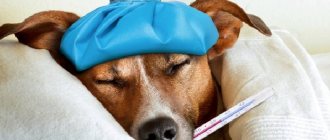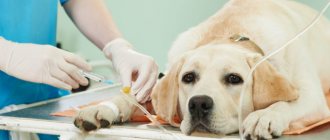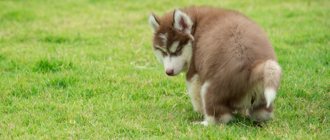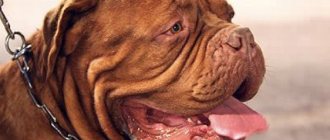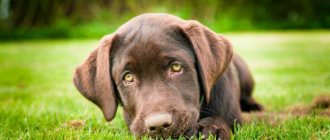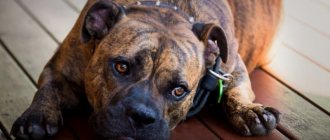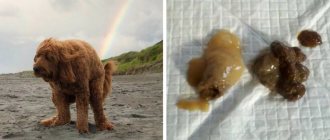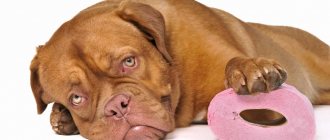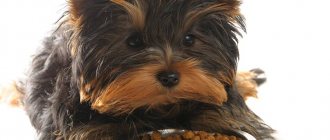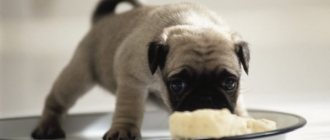Reasons for the appearance of greenery in animal stool
This shade occurs due to the release of large amounts of biliverdin and bilirubin - bile enzymes. In this case, the feces take on a liquid form.
There is no need to worry if the situation is isolated. When the trouble recurs, it’s worth thinking about what led to such consequences .
Common reasons:
- Diseases.
- Incorrect care.
- Allergy.
- Use of antibiotics.
- Vaccination.
- Changing teeth.
Diseases
Many diseases are asymptomatic: the pet plays, eats well, feels great, but the disease develops at this time.
Green stools are often caused by the following diseases:
- Problems with the liver.
Impaired intestinal motility.- Cholelithiasis.
- The development of pathogenic bacteria in the animal's body.
- Inflammatory processes in the gastrointestinal tract.
- Parasitic and fungal diseases that negatively affect the entire body as a whole.
- Intestinal infections.
Greens in the stool are a clear symptom of excess bile production in the body.
Improper care
Experienced breeders know how to properly care for their pets. Another thing is for beginners who often repeat common mistakes:
- Sudden changes in feeding schedule. When the body “does not know” when to eat, it is unable to produce the required amount of gastric juice in advance. Excess bile excreted in feces helps in this matter. A four-legged animal should be taught a routine from childhood. The dog must know how many times a day food is brought to it and at what time.
Sudden change in diet. The transition from drying to regular food or vice versa should occur gradually. Failure to comply with the condition leads to gastrointestinal upset.- Feeding with low quality feed. There is nothing healthy in such food. Food only provokes the development of health problems. It is better to refrain from economy class feed.
- Eating stale food. Some people, when getting a dog, believe that this is the same piglet that can be fed everything, from fatty and salty to stale. You can't do this.
Proper dog care will keep your pet healthy.
Allergy
Allergic reactions manifest themselves in different ways, including loose stools mixed with greens.
Some dogs develop mucus with red streaks in their stool. This usually indicates a food allergy. Over time, symptoms intensify.
Taking antibiotics
Antibiotics negatively affect the intestinal microflora. To prevent problems from occurring, it is advisable to give your dog probiotics in a course.
Otherwise, your four-legged friend will periodically experience bowel disorders.
Vaccination
After vaccination, the puppy’s health sometimes worsens: the body temperature rises, appetite disappears, diarrhea appears, and sometimes vomiting.
After a day, the animal again becomes active and joyful. Unpleasant moments also occur in adult animals.
Changing teeth
The process is accompanied by a number of negative aspects, including an upset stomach with an admixture of greens in the stool. In this case, you should not be afraid - this is a temporary phenomenon.
Deviation No. 1: Green feces
Stools acquire a green color due to the large secretion of bile or bile enzymes known as bilirubin and biliverdin. There may be several reasons for the appearance of such bowel movements:
- Inflammation of the gastrointestinal tract.
- Fungal infectious diseases, in which a fungal colony is able to multiply in the internal tissues and organs of the dog, disrupting their functions.
- Parasitic diseases caused by helminths, insect bites and other factors.
- Pathological abnormalities in the functioning of the liver and bile ducts.
- Cholelithiasis. The formation of stones in the gall bladder or bile ducts leads to stagnation of bile and is dangerous for the rupture of the gallbladder.
- External parasites. These include mites, scabies, lice-eaters and other blood-sucking representatives.
- Errors in diet planning. If the dog is prone to allergic reactions, manifestations of dysbacteriosis, or with an incorrectly selected diet, green stool can be a single symptom without causing pain in the animal. However, it is necessary to understand that a malfunction has occurred in the body’s functioning and if left untreated, the pet’s condition will worsen significantly.
What symptoms should you be wary of?
When you need to sound the alarm, seek the help of a specialist:
Reluctance to play, lethargy, weakness.- Sudden weight loss.
- Yellowing or blanching of mucous membranes.
- Regular urge to vomit (sometimes the animal vomits only drool).
- Changes in body temperature (increase, decrease).
- Poor appetite.
- Intense thirst.
- Black-green feces.
Having noticed something wrong, you don’t need to wait for the problem to go away on its own. Severe poisoning is dangerous in itself, and delaying it will only worsen the situation.
How to treat an animal
Having made a diagnosis, the doctor prescribes a number of medications and explains how to use them..
Groups of medications:
- antidiarrheals;
- preparations with enzymes;
- probiotics.
Antidiarrheal drugs
The main task of medications is to stop incessant diarrhea, which removes fluid from the body.
Atoxil, activated carbon, and Regidron are usually prescribed.
Probiotics
Beneficial bacteria normalize microflora, restoring intestinal balance. Today, pharmacies offer a large number of probiotics that help bring peristalsis back to normal in a short time.
Enzyme products
Enzymes are involved in the digestion process.
Their lack leads to problems associated with the gastrointestinal tract. Special medications help the body break down food. Popular:
- Pancreatin.
- Festal.
- Oraza.
Only a specialist should prescribe medications.
Deviation No. 5: Gray feces
Gray coloration of excrement is a rare phenomenon and corresponds to abnormalities in the pancreas or biliary system of the liver.
Gray feces may indicate the following abnormalities in the pet’s body:
- Alternating diarrhea and constipation. When the pancreas produces less secretion or the liver synthesizes less bile, the body stops processing lipids (fats), as a result of which food digestion is disrupted and peristalsis suffers (diarrhea, constipation).
- Rapid development of opportunistic microflora (Escherichia coli and other types of bacteria). Due to the reduction in the amount of bile produced, which is a bactericidal compound, a favorable environment for the proliferation of harmful bacteria is created in the intestinal lumen.
- Deterioration in the general condition of the animal, loss of appetite, exhaustion.
Normalization of nutrition as a method of therapy
Proper nutrition is the key to a healthy dog. If you notice unformed stool in a newborn puppy, you should not worry: this is how the body reacts to mother’s milk. After 2 months from the moment the bait starts, the situation will change, the feces will change color.
Adult animals are prescribed:
- starvation diet;
- change of diet.
Following nutritional rules is very important.
Starvation diet
It is usually resorted to in the first days after the onset of severe stomach upset. At first, the furry friend himself refuses to eat, after which the owner must refrain from feeding the fluffy.
However, clean water should always be available. Having noticed improvements in the dog’s condition, you can begin light feeding.
Diet for putrefactive microflora
Putrefactive microflora develops as a result of improper nutrition, leading to poisoning. To correct the problem, the doctor develops a feeding plan.
The animal is usually allowed to give:
- boiled lean fish;
- dietary meat after heat treatment;
- boiled rice, which you shouldn’t get carried away with to avoid constipation.
It is advisable to give up dry food for a while. Vegetables and fruits are gradually added to food in small quantities.
Based on the test results, the doctor allows you to return to your normal diet. If it was chosen incorrectly, the optimal diet is proposed based on the age and weight of the four-legged friend.
What to do if your dog has diarrhea?
Monitoring the quality of a pet's feces is the responsibility of any owner. The dog does not have the opportunity to complain that it has a stomach ache or feels unwell, so it is extremely important to constantly monitor the quality of your four-legged friend’s bowel movements in order to be able to provide him with timely help.
We recommend reading: Signs of a Cat Allergy
What is dog poop like?
However, dogs that eat dry food normally produce slightly different stool. In principle, it is similar to normal, but there is a lot of it. Often more than the dog has eaten. This is especially noticeable in dogs of decorative breeds. A dog can poop out as much as it is unclear how it ended up in it.
This “high potassium content” is due to the fact that dry food contains a lot of plant fiber, as well as other carbohydrates that are not natural food for predators. And dogs are predators. And therefore they cannot be fed porridge.
The fiber content of proper dog food should not exceed 6%. But in modern dry food it often reaches 28%.
In addition, dry food is enriched with ingredients such as soy, rice, and beets. And so-called “no-carbohydrate foods” usually include potatoes and peas.
It is obvious that all these components of food are not absorbed by dogs at all and come out. Therefore, a dog on dry food produces significantly more feces than a dog on natural meat feeding.
Those dogs that eat natural food with a very high calcium content (the food contains a lot of bones) produce little feces, and it has a light, sometimes almost white , color. The stool is usually hard and weak-smelling. Often the animal has a tendency to constipation.
All types of dog poop shown are normal. Signs of diarrhea are a cause for concern for owners.
Below are non-species with
Source
Mistakes that can lead to poor health
The Internet has led to the fact that most people treat themselves and treat their pets. An incorrect diagnosis leads to a deterioration in the animal's well-being .
Always dangerous:
- self-medication;
- thoughtless use of traditional medicine.
Self-medication
Independent choice of treatment leads to a blurred picture of the animal’s condition and complications when making a diagnosis. This can lead to the death of the pet.
It is better to do nothing than to give the dog the pills that came to hand first.
Unjustified use of folk remedies
What helps people is sometimes harmful to animals. Many plants are contraindicated for four-legged people. For smaller friends they are toxic and cause severe poisoning.
Treatment
The choice of treatment tactics directly depends on the cause that provoked the appearance of green stool. Only a qualified specialist can select the most appropriate therapy for your pet after receiving the results of diagnostic studies. It is highly not recommended to prescribe medications on your own, since illiterate use of medications can only aggravate the situation.
As a rule, for green diarrhea in dogs, antidiarrheal drugs, probiotics, adsorbents and enzyme agents are prescribed. In case of diarrhea due to dysbacteriosis, the main goal of treatment is to normalize the intestinal microflora, as well as prevent putrefactive processes.
If the cause of green diarrhea is an infectious disease, antibiotic therapy is prescribed. If there are additional symptoms, manifested in the form of vomiting, fever, antipyretic drugs, anti-inflammatory drugs, as well as drugs to help stop vomiting are prescribed. Intravenous administration of colloidal and physiological solutions using a dropper may also be prescribed.
The duration of the therapeutic course and dosage are determined by the doctor individually in each individual case, taking into account the severity of clinical manifestations, the nature of the disease and the age of the dog.
Prevention methods
Every owner should take care of the animal by following simple recommendations:
Feed your furry friend correctly, choosing the right time for this.- Never feed your dog from the table or give spoiled food.
- Treat regularly against fleas and worms.
- Periodically undergo a veterinary examination and receive treatment only from a specialist.
